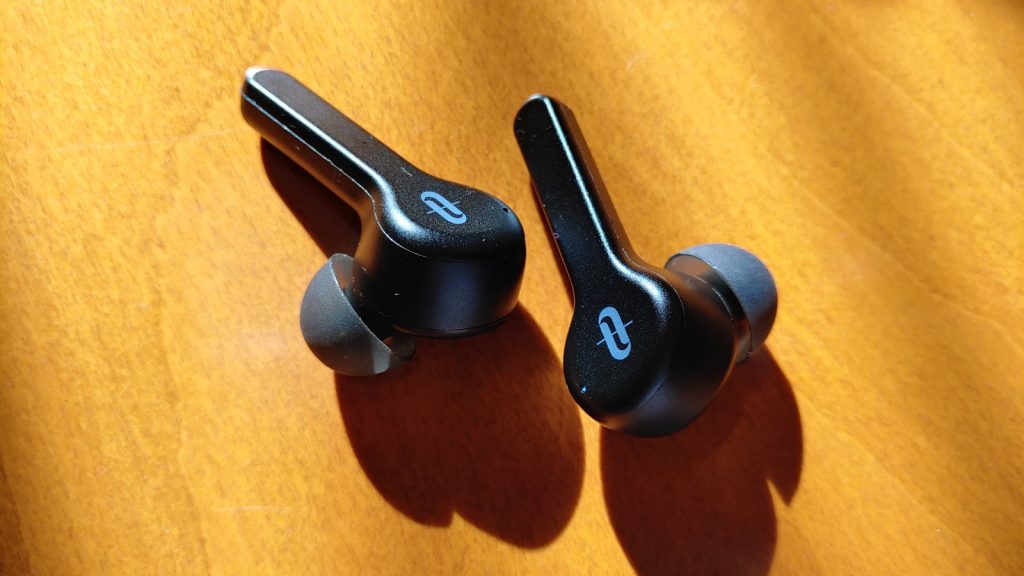AI isn’t coming. It’s already at your desk. And if you’re South African, chances are you’re ready to hit the ground running. A brand-new…
8 things to consider before buying true wireless earbuds

If you’re in the market for true wireless earbuds (TWEs), someone at some point has probably uttered these words to you: “Just buy AirPods”.
While Apple’s little buds exemplify what makes a good pair of true wireless buds, not all of us like glaringly ugly white tails drooping from our ears.
For that reason, this little piece was born.
As congested as the market is right now, there are ways companies differentiate themselves in the true wireless earbud sector. Some rely on aesthetics, others noise cancellation, and some just on price alone.
But while these are all great USPs, there are a few key factors you should consider before plunging your cash into a pair.
How is the battery life?
Cramming a battery into something smaller than a baby carrot isn’t an easy task, so we’d forgive companies for offering just two hours of playback per bud per charge.
This isn’t that much of an issue for TWEs though. Thanks to the companion charging case you slide your buds into, they should always be charged.
But be sure to understand just how long your buds — and your case — are set to last per charge.
Some examples of how long true wireless earbuds last in 2019:
- For the Taotronics SoundLiberty 53, this means a quoted five hours per bud, and 40 hours for the case.
- The Samsung Galaxy Buds have seven hours of charge in their case and six per bud.
- Apple’s AirPods hold 24 hours in their carrying case, and five hours per bud.
- The Huawei FreeBuds 3 holds four hours of charge in each bud, and 16 hours in its carrying case.
Be sure to consider how much battery life you require for your use case.
Are there any companion apps?
Gone are the days when simply connecting your Bluetooth buds to your device of choice was enough. Smarter buds in 2019 now arrive with nifty touch-powered features, like activating ambient mode or skipping tracks.
The Galaxy Buds can query Bixby. Apple’s AirPods can contact Siri. But these features — at least in the case of non-Apple buds — are powered through companion apps.
If you require enhanced features, you’ll need to download the companion app that applies to your buds. If not, this section shouldn’t be a problem for you.
But do take note: some features can only be enabled through the app, even if it is just via initial setup. And more importantly, some buds — like the Galaxy Buds and FreeBuds 3 — can only be updated via the app.
How’s the audio quality (for calls or music)?
Most buds have similar designs, but what looks like a duck may not sound like a duck.
Personally, the Klipsch T5 True earbuds have been the audio blessing I’ve needed in my life throughout my review period with them, but the other buds mentioned in this article don’t sound too bad either.
Be sure to understand which buds offer what in terms of hardware, microphone placement, audio codec support, as well as supported Bluetooth version. All these will affect sound quality and connectivity.
If your focus is music beyond multitasking or office work, you should absolutely consider testing each before buying. This is a particularly important point for the next segment too.
How do they fit in my ears?
If a pair of true wireless earbuds don’t properly fit your ear, they simply won’t live up to their potential audio performance. That’s probably the sentence that got you like “well, duh”. But it’s a genuine experience-breaking issue.
Much like a pair of shoes, if they hurt your feet, you’re not going to want to wear them. And unlike footwear, you can’t really break-in earbuds.
Decide if you want an in-ear design (Galaxy Buds, SoundLiberty 53, T5 True) or open-ear (FreeBuds 3, AirPods). Each design has their benefits.
- In-ear benefits: sound isolation is generally better which means crispier highs and thumping bass.
- Open-ear: allows you to hear the surrounding environment, as well as the music in your head (or are those voices?).
Do they feature active noise cancellation?
If you listen to music in a noisy area, say a plane or your sales team’s office, active noise cancellation is a must.
It’s regarded as a premium feature that you’ll generally find on more expensive headphones let alone earbuds. But some products, like the Huawei FreeBuds 3, also offer active noise cancellation despite being open-ear, and much cheaper.
Apple too has launched its AirPods Pro, in-ears that also offer ANC.
It’s a feature we’ll definitely see arrive on more buds in 2020, and it’s an exciting prospect. So decide before investing in a pair this year if you’d going to want ANC or not. You may have to wait a few more months.
It should be said, however, that noise-cancellation will always work better with in-ear buds than open-ear buds. And with some in-ear buds, passive isolation may be so good that you needn’t worry about ANC at all.
How much do they cost compared to my other options?
Another “duh” moment, probably, but price is a massive buying factor. Well, value for money, I should probably call it.
While most decent earbuds are priced above R2000, you can find gems far below this price. Hell, the SoundLiberty 53s are usually on sale for under R700.
Find the pair of buds you want, consider its features, and then compare those and its price to other buds. Maybe, just maybe, you can possibly find a pair from a company, or retailer, that offers the same for less.
How practical are they for daily use?
Style and status are attached to statement tech pieces, but true wireless earbuds should be considered as practical additions to your life.
With our previous point in mind about comfort, find a pair that’s ergonomic, comfortable, and most importantly, lightweight. You’d going to be lugging these around in a pocket, remember.
If you plan to wear them at the gym, be sure to research if they are water and dust resistant. This will be expressed with an IP rating.
Also be sure that your in-ear buds’ case can accommodate any ear-tips you may want to use.
Pay special attention to the case too. If you lose its charging cable, do you have a spare? Can it charge wirelessly?
Can I use them across all my devices?
Finally, there’s a chance you have another device in your care beyond a smartphone. Windows? MacOS? Linux? Be sure your wireless ear buds can accommodate your daily devices regardless of their OS.
Hell, maybe you’d want to use them with your smart TV. Do the math before dishing out the cash.
Final thoughts
While I’m still a firm believer in using wired earbuds well after Apple and Samsung thinks its old fashioned, true wireless earbuds have improved massively in 2019. Seriously. It’s been a wonderful year for the technology.
I expect these products to gain more features, including ANC and better battery life, in 2020. And who knows? Maybe the technology currently offered on premium buds will filter down into affordable products.
2020 will be an exciting year for true wirless earbuds.
Feature image: Andy Walker/Memeburn


